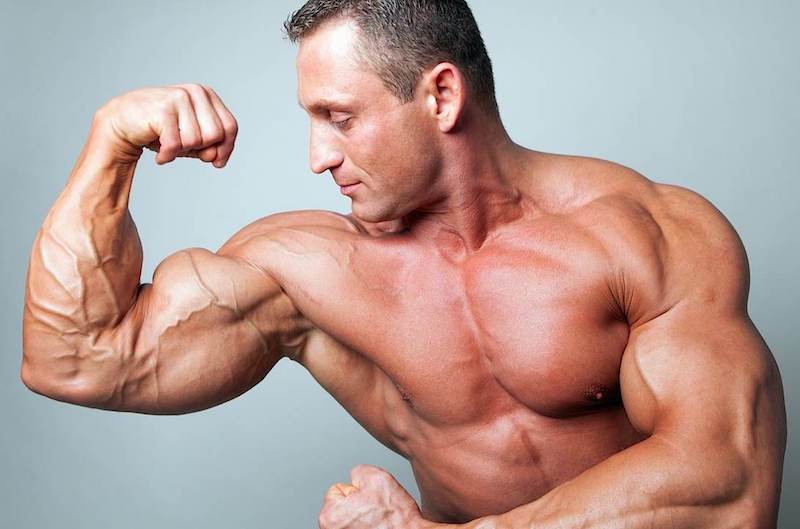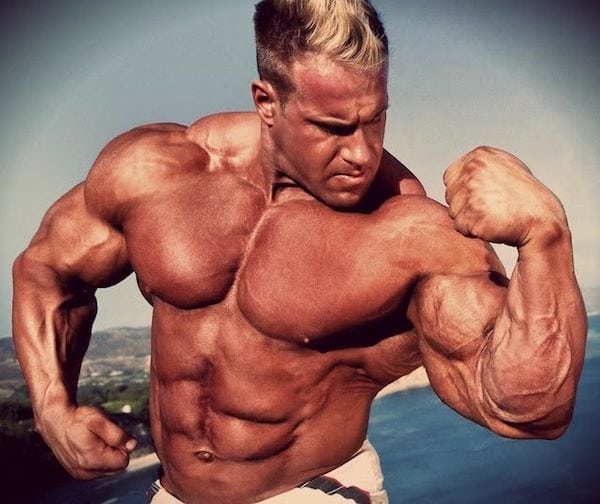No products in the cart.
Does Flexing Build Muscle? Benefits of Flexing

The only people who flex are people with big muscles, so naturally, it is fair to assume that flexing builds muscle right? In the same way that basketball must make you taller because so many basketball players are tall!
Okay, in all seriousness the question about whether flexing builds muscle is actually an interesting one.
In this article, we will explore how muscle growth occurs, and whether flexing can have a significant impact on it.[toc]
What Do We Mean By Flexing?
Technically everyone flexes every day, yep even your grandma flexes. Anytime you move you are flexing a muscle, the degree to which you flex will differ for each movement, but it is wrong to assume that anyone is living in a flex-free environment.
Flexing is where you contract a muscle isometrically for a prolonged period of time (less than a minute).
If you caught a tennis ball in both hands and held it to your chest you would be flexing your biceps – but not particularly hard. Holding a heavy box for 30 seconds would also be flexing your biceps, this time a bit harder. If you squeezed your bicep as tight as possible to show off to your friends you would … be incredibly vain. You would also be flexing maximally.
In this article we aren’t talking about run of the mill flexing though, we are talking about dedicated time spent flexing.
When bodybuilders are preparing for a competition, they spend many hours practising their routine. This is where you go on stage and pose in a position that is advantageous for displaying your muscles.
Many bodybuilders have claimed that practising their routine for hours on end has helped them develop their muscles further.
How Do You Increase Muscle Size?
As you can probably imagine, the science behind muscle growth is not brief. Entire textbooks have been written about the science of hypertrophy (“Science & Development of Muscle Hypertrophy” by Brad Schoenfeld being an excellent example), so trying to go in depth on the subject in this article would be impossible – without making the article 80,000 words long!
But we can give you a rough idea of what the mechanisms behind muscle growth are.
There are three mechanisms that determine muscle hypertrophy. These are:
- Mechanical Tension
- Metabolic Stress
- Muscle Damage
Below is a brief description of each:
Mechanical Tension
This can be split into two types, active tension and passive elastic tension.
The first type of tension would be flexing a muscle as hard as possible (important for this article) and the second (passive elastic tension) is where you are stretching a muscle for a prolonged period of time. Both of these create tension.
Dynamic exercises are supposed to be best for creating mechanical tension because they provide a combination of both forms of tension. The more mechanical tension you get in a workout, the greater the muscle gain – up to a certain point.
You might think that increasing mechanical tension would be all about increasing the weight lifted (to maximise both active and passive tension), but this isn’t necessarily the case.
For starters, increasing the weight too much can lead to a breakdown in technique.
For maximal mechanical tension, you need a full range of motion, you need time under tension, and you need tempo. If the weight is too heavy then none of that can occur.
But another reason is that studies have found a sweet spot at 90% of your one rep max, anything more than that actually reduces the effectiveness [1].
If mechanical tension was the only factor that influenced muscle growth, then flexing would probably not be very effective (though it still would be quite effective).
This is because no matter how hard you flex, it still won’t produce as much tension as a barbell loaded with 90% of your one rep max would. Luckily there are two other factors that can influence muscle growth.
Metabolic Stress
Imagine the scene, you’re on your last set of bicep curls. You’ve already hit five reps and you have ten more to complete.
As you curl the weight up your muscles are screaming, every rep hurts, you grunt, you fantasize about cheating each rep, but maintain that perfect form. At the end of the set, you can barely put the weight down.
That feeling is known as metabolic stress, and it represents a period in training where metabolites such as lactate are feeding the muscles.
The actual pain that is associated with high reps to exhaustion is actually a lack of oxygen travelling to the muscles, rather than something caused by lactate (which is often blamed for sore muscles).
Increasing metabolic stress can be achieved by either form of mechanical tension. You can stretch a muscle long enough to cause metabolic stress, and you can contract a muscle (flex) long enough to create metabolic stress.
Alongside mechanical tension, metabolic stress is crucial for muscle growth.
Lifting challenging weights (don’t necessarily have to be ridiculously heavy provided that you’re performing sufficient reps) with perfect form and tempo until exhaustion will get you incredible results. But there is one other mechanism that also affects muscle growth.
Muscle Damage
This last mechanism for growth represents your recovery after a workout. Remember the last time you returned to training after a long layoff? Perhaps you remember the feeling in your muscles after that session? Pain, pure agony. This is the result of muscle damage.
The more regularly you train, the less you will be affected by DOMS, but muscle damage will always follow a tough session.
This is actually a good thing, without muscle damage your muscles would not be able to grow.
During a workout small micro tears occur in your muscle fibres. These tears cause inflammation and soreness. When this happens insulin is released which transports proteins and other nutrients to the muscles. This starts the process of protein synthesis, a crucial aspect of hypertrophy.
For the most part, the more muscle damage you get the more protein synthesis, and therefore the bigger potential growth. However, you can have too much of a good thing (or bad thing depending on how you feel about sore muscles).
Excessive muscle damage can cause a reduction in muscle growth. It can also prevent you from training properly for the next couple of days, which indirectly causes a loss of potential gains.
Other Factors
Theoretically, the three mechanisms above are the main contributors to muscle growth, but without the following factors, your results will never be particularly impressive.
Your protein net balance is crucial for growth. This is a measure of the amount of protein being used (for muscle maintenance and recovery) and the amount of protein being consumed.
For muscle growth, you need to have a positive protein balance (more protein taken than used).
This allows your body to repair and rebuild damaged muscle fibres. Creating a neutral protein balance is essential during a diet, and you never want a negative protein balance.
It is for this reason that athletes require twice as much protein as sedentary people [2].
Rest and sleep are equally as important as protein as they can have a huge effect on hormone regulation. Poor sleep can cause a reduction in testosterone and growth hormone regulation, which can cause muscle gain issues.
A proven muscle building supplement won’t harm your gains either!
Can Flexing Build Muscle?

Now we get to the heart of the matter, does flexing cause muscle gain?
When we talk about flexing for bodybuilding we’re talking about maximal contractions for extended periods of time. You are literally flexing as hard as you can. This will not provide optimal mechanical tension in the same way that dynamic exercises (plyometrics for example) would because it is only performing active tension.
But still, there will be a great deal of tension built up during each flex of the muscle, and during the session as a whole. This will also lead to an increase in metabolic stress.
Your flexing session can last up to an hour (or more) if you’re really practising hard. These contractions will lead to a build-up of lactate, and a reduction in oxygen, so you should definitely feel the metabolic stress as the session progresses.
Finally, we have muscle damage, the final indicator of whether you have trained at a hard intensity or not.
A maximal contraction will cause micro-tears in the muscle fibres, which will lead to inflammation and swelling. Therefore muscle damage will occur, and muscle protein synthesis will be stimulated by a spike in insulin.
But could you gain muscle just through flexing your muscles? In other words without performing a specific exercise?
Does Flexing Alone Build Muscle?
Interestingly, building muscle through flexing muscles has been around for a very long time.
Electrical stimulation of muscles (usually abdominal belts) has been around since the sixties. Many people think that they are scams, but actually, a good quality electrical stimulation machine can help to build muscle.
A 2002 study in the Journal of American Physical Therapy Associates looked at the old Soviet experiments using electrical stimulations on muscles. The studies had found that people who used the machines regularly saw a 40% increase in muscle force [3].
Remember, these electrical stimulations are basically just flexing the muscles. The more expensive versions can vary the amount of force.
But what about manual flexing? Well, there is definitely enough evidence that it can help to some degree, but it is unlikely that flexing is going to be anywhere near as effective at building muscle as traditional bodybuilding training in the gym.
Let’s put it this way. If you were looking to build muscle, a flexing-only program would not be very effective. However, adding in a session of flexing on a day when you can’t make the gym would be an excellent idea.
Flexing as a Form of Active Recovery
Active recovery is low impact exercise that you can do while resting and recovering between training sessions.
A light jog, yoga, a medium difficulty hike, stretching, foam rolling etc … are all forms of active recovery.
You could add flexing into that category too. In any case, it’s definitely not a good idea to train and do a session of flexing on the same day.
Benefits of Flexing

The most obvious benefit of flexing is to practice your routine. This is particularly important if you are going to be performing in a bodybuilding competition.
The performance side of bodybuilding should not be underestimated. Having an incredible physique is never going to be enough to help you win … everyone will have a good body.
But how you pose will make or break your performance. Practising flexing will really help you in this area.
Flexing will also help to maintain muscle or even marginally increase muscle size. But only when it is combined with a well-planned training program.
Flexing alone is not going to make much of an impact.
Another possible benefit of flexing would be a carry over into your training. If you are practising maximal flexing during an off day, you may see better results when performing proper exercises in the gym.
Final Thoughts
For bodybuilders, flexing makes a lot of sense. It can help them prepare for their competitions, help them to maintain muscle during a cut (provided that you are consuming enough protein of course), and may even help a bodybuilder to increase muscle. There may even be carried over into their training.
For others, flexing is probably not necessary. If you have an hour to spend on flexing, you could probably be spending it better by training in the gym or performing a body weight routine.
At least you now have a perfect excuse for why you’ve spent twenty minutes doing the double bicep pose in your local gym. You’re just trying to build some muscle! Let us know how this excuse pans out for you.

Not sure I want to be flexing in front of everyone at the gym? Maybe I should buy a full length mirror for the house?
Good idea Harry. 😛
Isometric exercise actually does make you STRONGER… Bruce Lee was a fan and practitioner of this.
I would say isometrics is the best if you love to train hard because, eventually with gym or calisthenics you reach a limit if you have no one around your strength level but, with isometrics you can constantly get gains.